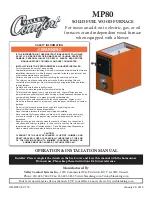
IO-213D
2/04
17
• Thirty (30) seconds after the main valve is energized the
circulating air blower will be activated.
• The furnace will remain in operation until the demand for
heat is satisfied.
• Once the demand is satisfied the venter will shut off, and
the circulating air blower will shut off after the field
selectable time off is attained.
• The furnace will remain dormant until the next demand for
heat.
Cooling Mode
• The control checks for an open limit. If an open limit is
detected, the furnace will remain inoperable until the
condition is corrected. During an open limit condition, the
circulating air blower will be energized. The status light
will blink four (4) times.
• A demand for cooling is initiated.
• The condenser contactor will close.
• After approximately five (5) seconds, the circulating air
blower will start on the cooling speed.
• After the room thermostat is satisfied, the condenser
contactor will open.
• The circulating air blower will remain in operation for
approximately sixty (60) seconds.
REMOVING AN EXISTING APPLIANCE
When replacing an existing appliance, the resulting
installation must comply with all local codes, or in the
absence of local codes, to the National Fuel Gas Codes
ANSI Z223.1 and/or CAN/CGA B149 Installation Codes as
well as these installation instructions.
If the installation of this GMNT furnace requires that an
existing appliance be removed from a venting system, which
still serves another gas, fired appliance, this may require
that the existing vent be re-sized. The following steps shall
be performed with each appliance connected to the venting
system placed in operation while any other appliance
connected to the venting system are not in operation;
a. Sealing unused openings in the venting system;
b. Inspect the venting system for proper size and horizontal
pitch, as required in the National Fuel Gas Code, ANSI
Z223.1 or the CAN/CGA B149 Installation Codes and these
instructions. Determine that there is no blockage or
restriction, leakage, corrosion and other deficiencies,
which could cause an unsafe condition;
c. In so far as practical, close all building doors and windows
and all doors between the space in which the appliance(s)
connected to the venting system are located and other
spaces in the building. Turn on clothes dryers and any
other appliance not connected to the venting system. Turn
on any exhaust fans such as range hoods and bathroom
exhausts, so they shall operate at their maximum speed.
DO NOT operate a summer exhaust fan (whole house
fan). Close fireplace dampers;
d. Follow lighting instructions. Place the appliance being
inspected in operation. Adjust the thermostat so the
appliance shall operate continuously;
e. Test for draft hood equipped appliance spillage at the relief
opening after five (5) minutes of burner operation. Use the
flame of a match or candle;
f. After it has been determined that each appliance connected
to the venting system properly vents when tested as
outlined above, return all doors, windows, exhaust fans,
fireplace dampers and any other gas-burning appliance
back to their previous condition of use;
g. If improper venting is observed during any of the above
tests, the venting system must be corrected.
INSPECTING AND CLEANING THE HEAT EXCHANGER
CAUTION
LABEL ALL WIRES PRIOR TO DISCONNECTION WHEN
SERVICING CONTROLS. WIRING ERRORS CAN CAUSE
DANGEROUS AND IMPROPER OPERATION. VERIFY
PROPER OPERATION AFTER SERVICING.
It is the obligation of the installer to advise the user to have
the furnace inspected and cleaned annually. To clean the
heat exchanger, perform the following:
• Adjust the room thermostat to its lowest setting.
• Turn off the gas and electric supply to the furnace.
• Remove the control access door.
• Open the gas supply union.
• Disconnect the gas supply line attached to the gas valve.
• Remove the wires connected to the gas valve.
• Remove the burner box assembly. Care must be exercised
to avoid damage to the igniter.
• Inshot burners should not require cleaning. However, if
they exhibit signs of corrosion they can be cleaned by
brushing with a stiff wire brush.
• Remove the vent from the furnace venter blower.
• Remove the venter blower and collector box.
• With a stiff wire brush on a flexible handle, remove any
loose scale from the heat exchanger at both the flue and
burner openings.
• Use a 1/2" diameter brush to remove any deposits in the
secondary heat exchanger.
• With a vacuum, remove any loose scale dislodged and
any additional debris found in the heat exchanger.
• Visually inspect the heat exchanger cells for any cracks or
openings using a bright light.
•
If any failures are discovered, it is important to disable
the furnace and notify the user to ensure that it remains
inoperable until repairs are implemented.
• Reassemble the furnace in the reverse order.
Note:
No
additional screws or wires are supplied with this product.
All components must be reassembled to avoid an unsafe
condition.
• Reconnect gas supply and check for leaks using a soap
solution. If a flexible gas line is used, examine it for cracks
or weakness. Replace if necessary.
• Restore electrical power.
• Follow the lighting instructions to place the furnace into
operation.
Note:
It is important to use a pipe joint compound that is
resistant to the effects of L.P. gas.




































